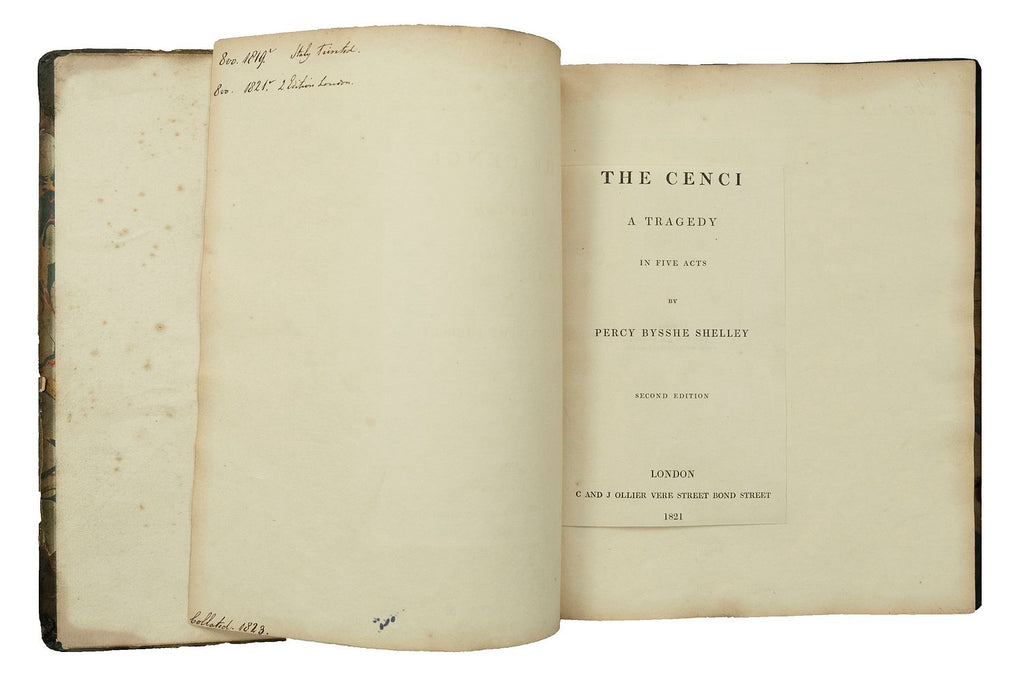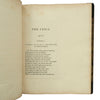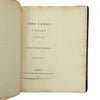The Cenci. A Tragedy. In Five Acts
SHELLEY, Percy Bysshe







London: C and J Ollier. 1821.
Second edition. pp. xvii (but xv), 104. Lacking half title. The original book has been disbound and the pages cut, very neatly and expertly and then carefully pasted at the hinge edge on a leaf of plain white paper so that the leaves of text are interleaved with the plain leaves. This is one way in which prompt books were made, allowing for notes and directions to be written on the plain leaves without disturbing the text. The leaves of text are cut to measure 151x95mm and the plain paper is 235x190mm. Bound in contemporary tan half calf, marbled paper covered boards. Rebacked with spine lettered in gilt. The centre of the upper and lower covers has a circular morocco label stamped in gilt with a coat of arms around which, in a circular band is stamped in gilt in gothic lettering, Johannes Ludovicus Gautier. Apart from some scuffing to the boards and bumping to the corners, the binding is in very good condition. Internally it is in fine condition with a little marking to the blank pages. On the verso of the front free end paper is inscribed in Gautier's hand, "8vo. 1819. Italy Printed. 8vo. 1821. 2 Edition London. Collated. 1823."
This unique and somewhat eccentric book contains an interesting story and set of connections. The name on the label on the covers is Johannes Ludovicus Gautier. Almost nothing is known about him but we do know that he bought books from the collection of the actor John Philip Kemble. The collection included numerous prompt books belonging to Kemble, including Shakespeare’s King John and Julius Caesar (which are held at the Folger) and William Wycherley’s The Plain Dealer (at the Huntington). John Kemble retired from the stage in 1817 and mainly lived abroad until his death in Lausanne in 1823. It seems that most of his books were sold in Switzerland in 1821. Those bought by Gautier are all bound in the same way as this copy although some of them have Kemble’s arms and name on the upper cover in the same style as those of Gautier’s. It seems that Gautier had all the books he acquired from Kemble bound in this way. Although there is no evidence on the book itself that Kemble owned this prompt book of The Cenci, the connections and associations all point to his having done so.
Shelley wrote The Cenci in 1819 intending that the part of Beatrice be played by Elizabeth O’Neill. Shelley had seen her perform at Covent Garden Theatre and, although he was not, as Mary Shelley noted, particularly keen on the theatre, he was so struck by O’Neill that he composed his first play for her. In the event, she retired from the stage in 1819 when she married a wealthy Irish MP. John Kemble was the leading male actor at Covent Garden until his retirement and a powerful figure in the London theatre. He was visiting Dublin in 1814 and, one evening at the theatre, saw Elizabeth perform. He was so impressed that he brought her to London that year where she made her debut as Juliet to huge acclaim. Given the connection between Kemble and O’Neill and Shelley’s fascination with Elizabeth, it seems likely that Kemble and Shelley would have met in the years before Shelley wrote The Cenci. After the play was published, in Italy in an edition of 250 copies, Shelley asked a friend to approach the manager of Covent Garden Theatre (Kemble and O’Neill’s theatre) to see if it could be staged there. The manager, Thomas Harris declared The Cenci “so objectionable” that it could not be put on. Despite this, a second edition of the work was published in 1821.
It is quite possible that John Kemble retained his links with Covent Garden theatre and that he acquired this copy through his connections there. The copy has clearly been prepared for use as a prompt book. The fact that the 1821 edition has been prepared in this way suggests that there were still plans to try and stage The Cenci. Perhaps Kemble harboured thoughts of putting on his own production or perhaps he was given this by a theatre colleague who had made it for his or her own use in some future production. It is a fascinating and tantalising object.
